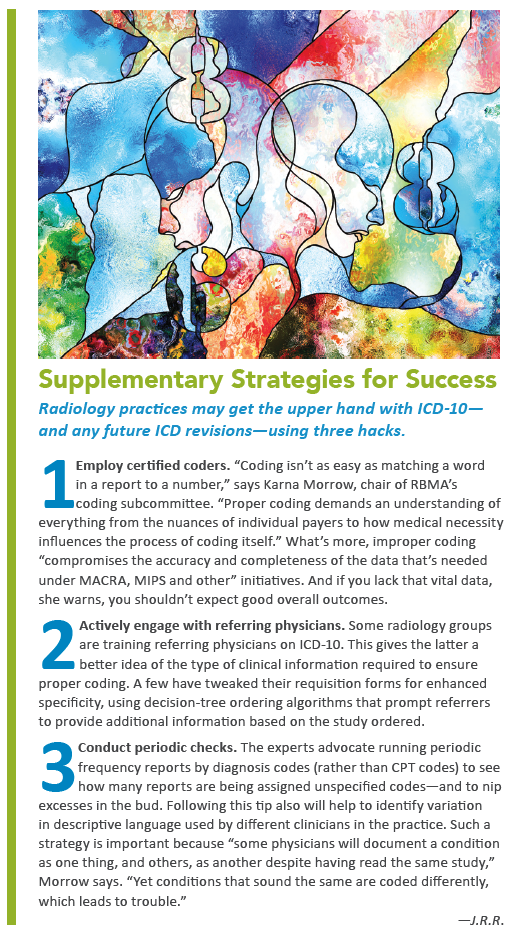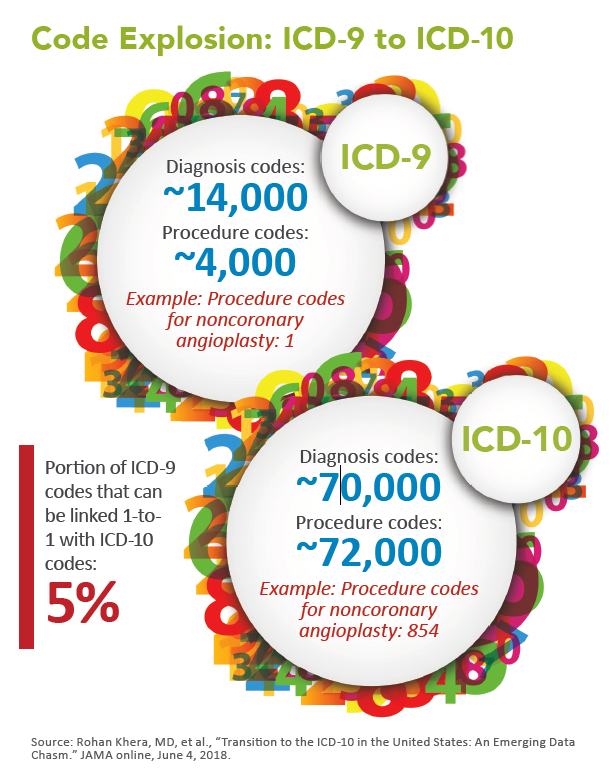ICD-10's Mixed Bag for Medical Imaging
Unbeknownst to most healthcare consumers, significant change swept across the U.S. healthcare system on October 1, 2015. That was the day the long-awaited 10th version of the In-ternational Classification of Diseases finally went live. The implementation of the update—aka ICD-10—ushered in an era of highly detailed diagnostic coding. This may have seemed a small step for members of the general public who heard anything about it, but it represented a giant leap into the unknown for providers looking to get fully and properly paid for their services.
Adding to the drama was ICD-10’s difficult delivery. Its start date had been pushed back twice before as providers, payers and software vendors signaled their collective unreadiness for the change. For providers, including radiologists, the looming pain points included hits on cash flow and burdens on administrative resources.
Today, three years after the sounding of the ICD-10 starting gun, things remain jostled across healthcare. In radiology, initial fears of disaster proved mostly unfounded, yet subsequent reports of trouble have indeed surfaced. Overall, according to several experts, the dust is settling and coders are keeping up. And that’s a good thing, since the World Health Organization is forging ahead with ICD-11 and, in fact, already has a beta draft available for perusing.
But let’s not too far ahead of the news. There are plenty of consequential—and mixed—results to consider with ICD-10 to date.
WHAT DID YOU EXPECT? 
Fortunately, heading in, the radiology community had realistic expectations about the move to ICD-10 and what it would mean for day-to-day business. The not-so-good news is that, for many, the expectations included some headaches.
“For the most part, there haven’t been any surprises,” reports Karna Morrow, chair of the coding subcommittee of the Radiology Business Management Association (RBMA). Which is to say that radiology groups anticipated a lack of sufficient patient information from referring physicians—and that’s exactly what’s been playing out in many places.
“It has been a constant battle, with radiology practices receiving incomplete clinical histories from emergency rooms and referrers of every type,” Morrow tells RBJ. “This has resulted in the [still-widespread] use of unspecified codes and, ultimately, claims denials based on insufficient information, with radiologists still financially liable for incomplete clinical histories.”
The latter has proven to be a particularly sharp thorn in the side when complex procedures such as CT and MRI scans are performed on Medicare recipients, Morrow notes. Medicare does not require preauthorization for these procedures, but it will subsequently deny the associated claims due to incomplete information and, hence, unspecified codes.
Adding insult to injury, according to Morrow, some radiologists are reluctant to nudge referring providers to get the clinical information they need. The fear: losing referrals to the competition.
What’s more, there have been some complications wrought by some particular ICD-10 codes. Morrow cites as an example N63 (“unspecified lump in breast”). Medicare has aimed to reduce the number of unspecified codes on the ICD-10 list, but in October 2017, it added another “unspecified” code under the N63 umbrella. Now billing staff must work with N63.0 (“unspecified lump in unspecified breast”) on top of multiple codes that classify unspecified lumps by location in the breast. These include such intricate sub-classifers as N63.10, “unspecified lump in breast, unspecified quadrant” and N63.22, “unspecified lump in left breast, upper inner quadrant”).
Sources report that many radiology constituents recognize the need for, and appropriateness of, unspecified codes in certain situations. That’s the case when, say, a patient provides a history involving an injury but doesn’t remember the specifics. However, they don’t see the need for certain codes outside this category, such as those that refer to appendages. Patients could, for example, easily tell or remember in which breast a lump was discovered, making N63 and N63.0 unnecessary.
PREPARATIONS PAID OFF
For some, the conversion from ICD-9 to ICD-10 has been a relatively stress-free experience. Emory Healthcare, which operates seven hospitals in Georgia, is a case in point. “We had concerns that the code conversion impact factor (CCIF) would be significant in at least some cases and that there would be delays in collections,” says Margaret Fleming, MD, who co-authored a study of claims data on well more than half a million radiology cases handled at Emory.
Instead of such falloff, the researchers found the operational impact of the ICD-10 transition to be far less than anticipated not only on CCIF but also cash flow.
For the study, published in JACR last January (Jalilvand et al., “Code Conversion Impact Factor and Cash Flow Impact of International Classification of Diseases, 10th Revision, on a Large Multihospital Radiology Practice”), the team calculated CCIFs as the number of actual 90th-percentile ICD-10 codes during the post-implementation year divided by the number of 90th-percentile ICD-9 codes in calendar year 2014.
Further, to estimate the transition’s impact on professional-component cash flow, the researchers calculated the average number of days claims remained in accounts receivable after the 2015 kickoff date. They compared these figures with the average number of days claims remained in accounts receivable over the 12 months prior to that day.
On analysis, the findings worked out to a post-implementation CCIF of 1.6 for the radiology department. The anticipated departmental CCIF, predicted using from earlier research, had been much higher—a whopping 6.
“Although we did find an increase in the total number of actual codes used by imaging services, the previous projections for radiology overestimated the CCIF by 369 percent overall on the department as a whole,” write Fleming and her co-authors in the study report. “This suggests that a significant portion of the new codes added by ICD-10 related to radiology and imaging are either not or only rarely used,” in turn impacting the post-implementation experience in a good way.
To this Fleming adds that only a tiny portion of ICD-10 codes were used to report patients’ primary diagnoses.
“Going from ICD-9 to ICD-10 didn’t make, and hasn’t made, much of an impact on the accounts receivable side,” she tells RBJ. In the 12 months before the change, billable claim time in accounts receivable ranged from 33 to 40 days, versus 33 to 36 days following the implementation. On average, billable claims remained in accounts receivable status for 36.4 days prior to the transition and for 34.9 days afterward.
“We do have an occasional payment glitch, but it isn’t serious, and it isn’t necessarily related to ICD-10,” Fleming adds.
What’s hard to say is how generalizable their findings are to the rest of radiology. At Emory, preparation for the transition was methodical as well as thorough. Coders, administrative staff, technical team members and physicians were all educated as to the importance of capturing diagnostic information with ICD-10 in mind. The training included a department-wide initiative aimed at conditioning technologists to attempt to capture what Fleming describes as the “what, when and where” of each case.
“We shared specifics with each subspecialty pertaining to what the changes with codes would be,” Fleming says. “For instance, with breast imaging, we knew there would be only a few codes and not too many changes, but for musculoskeletal imaging, we pointed out that there would be a tremendous increase in the number of primary ICD-codes.” This would include accounting for such details as laterality, acuity and more specific anatomic locations. “Knowing what kind of information would need to be included in reports under ICD-10 was a tremendous help.”
 ‘UNSPECIFIED’ IS UNWELCOME
‘UNSPECIFIED’ IS UNWELCOME
At Cincinnati Children’s Hospital, clinicians presumed the transition from ICD-9 to ICD-10 would present some challenges—and it has. Radiologist Alex Towbin, MD, chair of radiology informatics, says a number of coding-engine glitches, for example, still have to be fixed.
“Often, unspecified ICD-10 codes stem from the fact that, while the correct information is included in the report, it isn’t included in the impressions,” Towbin explains. He offers the example of an orthopedic case in which the coding engine identified only the presence of a fracture in the distal third of the right radius and assigned the ICD-10 code S52.501A (“initial encounter for unspecified closed fracture of the lower end of the right radius”) rather than a transverse fracture of the distal right radius, with the assignment of ICD-10 code S52.531A (“initial encounter for closed Colles fracture of right radius”).
“We’ve spoken with our vendor about this type of limitation in the commercial coding engine and how it’s causing trouble when it comes to ICD-10,” Towbin says, “but the vendor hasn’t done anything to eliminate the deficiency.”
The ongoing potential for unspecified codes to confound processes even when clinical histories are complete and correct is also troublesome.
“Yes, better clinical histories can increase the ability to come up with more specific ICD-10 codes, but other factors come into play,” Towbin says. “A code is based on clinical history if a study is interpreted as normal. If not, the code is based on the imaging diagnosis, with coders and coding engines using the information in reports to find the most appropriate, most specific code.”
In these scenarios, the clinical history doesn’t enter the picture. And that lack “opens the door for an unspecified code” to enter.
Physicians in other medical specialties now have a solution to this problem: clinical support with automated ICD-10 coding. “When you have clinical decision support tools built into an EMR system, it’s possible to enter diagnoses and build ICD-10 code in real time,” Towbin points out. “Unfortunately, radiology-based voice dictation tools don’t yet have this kind of functionality.”
Such headaches notwithstanding, Cincinnati Children’s has minimized what Towbin deems a significant portion of the challenges that have accompanied its migration to ICD-10. It’s done so with a two-part quality-improvement initiative documented in a study senior-authored by Towbin and published by JACR this February, “A Comprehensive Approach to Convert a Radiology Department From Coding Based on International Classifi cation of Diseases, Ninth Revision, to Coding Based on International Classification of Diseases, Tenth Revision.”
WINING WITH STRUCTURED REPORTS, IMPROVED HISTORIES
The initiative kicked off in October 2013, when 10 radiologists across all subspecialties were pre-selected based on their high case volume. The rads were asked to compile baseline data for all possible types of radiology reports from every department modality. All understood that the overall goal was fine-tuning radiology reports so they’d meet the documentation requirements of ICD-10 coding.
The intervention and research team set as a specific aim decreasing the proportion of reports assigned an unspecified ICD-10 code from a baseline of 43 percent to an a priori goal of less than 29 percent.
Towbin, Morgan McBee, MD, and colleagues first analyzed the baseline data and pulled aside reports with high counts of unspecified ICD-10 codes as assigned by computer-assisted coding software. Next, the team launched the two-part QI project. For the first part project leaders had technologists improve clinical histories by gathering information directly from patients or their clinicians. The team used speech-recognition software to import this info into the associated radiology reports.
The second part of the project involved standardizing report terminology and creating four different structured report templates. The object was to find out which templates brought back the fewest reports with unspecified ICD-10 codes as assigned, again, by an automated coding engine.
In all, the researchers found, 43 percent of 12,077 radiology reports in the baseline analysis had an unspecified ICD-10 code. The majority of deficiencies were for X-ray reports, and common problems included insufficient clinical history and lack of detailed descriptions of fractures.
After standardizing terminology and testing different structured reports for X-rays obtained for fractures, the rate of radiology reports with a complete clinical history jumped from 58 percent to more than 95 percent. In addition, the total number of reports containing an unspecified ICD-10 code improved from 43 percent at baseline to 27 percent over the course of the study period.
“With the transition from the ICD-9 to ICD-10 system, which requires increased specificity in documentation from medical providers, the number of codes has expanded dramatically,” the authors note in their discussion. “We have shown that the transition of a radiology department from ICD-9 to ICD-10 can be achieved through the use of structured reporting and quality improvement methodology.”
DON’T LOOK NOW, BUT HERE COMES ICD-11
With three years of ICD-10 under their belts, some radiology practices and departments are already looking ahead to ICD-11. This next iteration is expected to be approved by the WHO later this year, and successful ICD-10 adopters the U.S. may be eager to start building on their momentum as soon as possible. They would do well to wait for draft finalization before making any decisive moves, suggests Fleming.
“Given our findings and experiences with CCIF, we think it’s a bad idea to get ready for ICD-11 using future projections that rely on an increase in the number of primary codes, and don’t take account code frequency into consideration,” she says. “This is because they present only worst-case scenarios, instead of most-likely ones.”
Radiology practices may need to utilize meaningful projection algorithms as they ready themselves to set off on the ICD-11 path. These algorithms should map existing ICD-10 codes to future ICD-11 codes in a more granular manner, with the disproportionate utilization of new ICD-11 codes considered when new predictive models are being proposed.
Additionally, Fleming and colleagues believe “thoughtful and proactive preparation and education” completed in anticipation of stepping up to ICD-11 may entail leveraging automated or semi-automated tools, like natural language processing, on a case-by-case basis.
“Conversion is never going to be an exact science,” she says. “However, preparation—keeping in mind experiences from one revision of any ICD set to the next—is an excellent start.”
